Held Back by Uncertainty
Finance & Development, March 2013, Vol. 50, No. 1
Nicholas Bloom, M. Ayhan Kose, and Marco E. Terrones
Recoveries are slowed when businesses and consumers are unsure of the future

SOME economists and politicians argue that the two years of harsh times visited on the United States and euro area during the Great Recession of 2008–09 should have been followed by rapid recoveries. Milton Friedman—the late Nobel Prize–winning economist—called this the “guitar string” theory of recessions. When you pull a guitar string down, then release it, the string bounces right back. And the farther you pull it down, the faster it returns.
However, the economic performance in many advanced economies since the Great Recession has not followed that script. Instead, the deep recessions in those economies were followed by recoveries that have been disappointingly weak and slow. It is as if the guitar string was pulled down so hard that it snapped.
These developments are something of a mystery: Why has the current recovery been so slow? Some argue that recoveries following financial crises tend to be slow because the legacy of the crisis—balance sheet repair, weak credit expansion, and lingering problems in housing markets—weighs on activity (for example, Claessens, Kose, and Terrones, 2012). This argument certainly has its merits, considering the historical record.
However, the ongoing recovery has been different at least in one important dimension from the earlier ones—whether associated with financial crises or not. It has experienced bouts of elevated uncertainty. This suggests a complementary explanation for the anemic recovery, one that emphasizes the roles played by macroeconomic and policy uncertainty in curtailing economic activity. Businesses have been uncertain about the fiscal and regulatory environment in the United States and Europe, and this fear of an unknowable future has probably been one of the factors leading them to postpone investment and hiring. This is clearly illustrated in a recent survey in the United States by the National Association for Business Economics (Economic Policy Survey, 2012), which reported that the “vast majority” of a panel of 236 business economists “feels that uncertainty about fiscal policy is holding back the pace of economic recovery.”
How important is uncertainty in driving economic activity? This article addresses that question by analyzing the main features of uncertainty and its impact on growth.
Here, there, and everywhere
Economic uncertainty refers to an environment in which little or nothing is known about the future state of the economy. There are many sources of economic uncertainty, including changes in economic and financial policies, different views about growth prospects, productivity movements, wars, acts of terrorism, and natural disasters. Although uncertainty is difficult to quantify, recent research has been able to develop a number of measures using a wide range of approaches (see box).
Measuring uncertainty
It is a challenge to quantify uncertainty because it is not an observable variable but rather one that is deduced from others. In the language of statistics, uncertainty is a latent variable.
But it is possible to gauge it indirectly in a number of ways, using measures that emphasize distinct aspects of uncertainty that an economy faces over time. Some of the measures focus on macroeconomic uncertainty—including the volatility of stock returns, dispersion in unemployment forecasts, and the prevalence of terms such as "economic uncertainty" in the media. Others consider uncertainty at the microeconomic level, which is often measured by various indicators that capture variation across sectoral output, firm sales, and stock returns and dispersion among forecasts by managers in manufacturing firms (Bloom, 2009; Baker, Bloom, and Davis, 2012).
Because we are concerned primarily with macroeconomic uncertainty, we concentrate on four measures based on the volatility of stock returns and economic policy. The first is the monthly standard deviation of daily stock returns in each advanced economy in our sample of 21 countries, which captures uncertainty associated with firm profits and is also shown to be a good proxy for aggregate uncertainty (see Chart 1). The second is the Chicago Board Options Exchange Volatility Index (VXO), which is an indicator of the implied volatility of equity prices calculated from S&P 100 options. The third refers to uncertainty surrounding economic policies in the United States and euro area and is a weighted average of three indicators: the frequency with which terms like "economic policy" and "uncertainty" appear together in the media; the number of tax provisions that will expire in coming years; and the dispersion of forecasts of future government outlays and inflation (see Chart 2). The fourth, which represents uncertainty at the global level, captures the common movement in the first measure using data for the six major advanced economies with the longest available series (Chart 1).
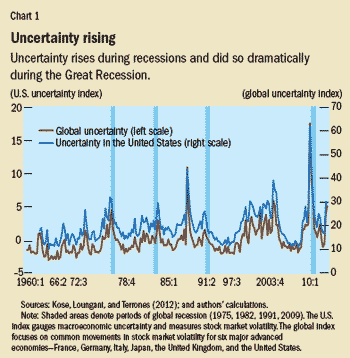
It does not matter which measure is used: it is clear that uncertainty has increased in recent times (see Chart 1). Uncertainty about economic policies in the United States and the euro area has surged since the 2008 recession, and remained stubbornly high ever since (see Chart 2). In the United States, uncertainty has recently been driven primarily by wrangling over fiscal policy, including taxes and government spending, and long-term structural issues, such as health care and regulatory policies and entitlement programs—such as the government-sponsored retirement plan Social Security and old-age health plan Medicare. Interestingly, monetary policy uncertainty does not appear to be one of the major factors behind the recent rise in policy uncertainty, possibly because of low and stable inflation and interest rates.
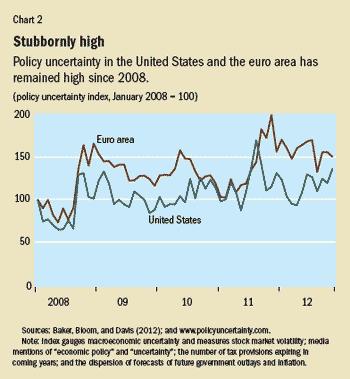
At the national level, uncertainty about the economy runs contrary to the business cycle. During expansions, macroeconomic uncertainty is, on average, much lower than during recessions, regardless of the measure we use (see Chart 3). Likewise, microeconomic uncertainty about specific industries or companies, measured by the volatility of movements in plant-level productivity in the United States, also behaves countercyclically and reached a post-1970 high during the Great Recession (Bloom and others, 2012).
Uncertainty and economic activity
However, it is difficult to establish causality between uncertainty and the business cycle. Does uncertainty drive recessions or do recessions lead to uncertainty? Although it is hard to provide a conclusive answer to this question, economic theory does point to clear channels through which uncertainty can have a negative impact on economic activity.
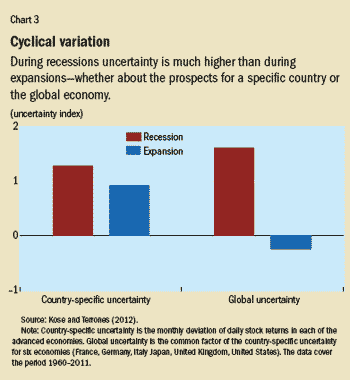
On the demand side, for example, when faced with high uncertainty, firms reduce investment demand and delay projects as they gather new information, because investment is often costly to reverse (Bernanke, 1983; Dixit and Pindyck, 1994). The response of households to high uncertainty is similar to that of firms: they reduce their consumption of durable goods as they wait for less uncertain times. On the supply side, firms’ hiring plans are also negatively affected by higher uncertainty, reflecting costly adjustment of personnel.
Financial market problems, such as those we have witnessed since 2007, can amplify the negative impact of uncertainty on growth. For example, uncertainty leads to a decline in expected returns on projects financed with debt and makes it harder to assess the value of collateral. As a result, creditors charge higher interest rates and limit lending during uncertain times, which reduces firms’ ability to borrow. The decline in borrowing causes investment to contract, especially for credit-constrained firms, and results in slower productivity growth because of reduced spending on research and development. These factors together can translate into a significant reduction in output growth.
Empirical evidence suggests that uncertainty tends to be detrimental to economic growth. The growth rate of output is negatively correlated with macroeconomic uncertainty. Moreover, a relatively small, 1 standard deviation, increase in uncertainty is associated with a decline in output growth of between 0.4 and 1.25 percentage points, depending on the measure of macroeconomic uncertainty (Kose and Terrones, 2012).
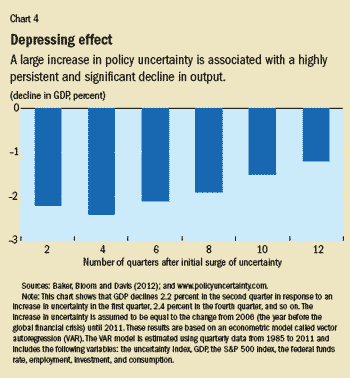
Policy-induced uncertainty is also negatively associated with growth, with policy uncertainty increasing to record levels since the Great Recession. Specifically, the sharp increase in policy uncertainty between 2006 and 2011 may have stymied growth in advanced economies (Bloom, 2009; Baker and Bloom, 2011; Bloom and others, 2012; Hirata and others, forthcoming). Empirical evidence indicates that such a large increase in policy uncertainty is associated with a highly persistent and significant decline in output (see Chart 4).
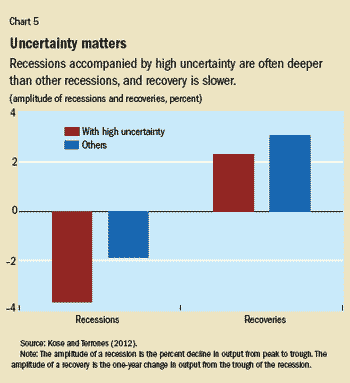
The degree of economic uncertainty also appears to be related to the depth of recessions and strength of recoveries. In particular, recessions accompanied by high uncertainty are often deeper than other recessions (see Chart 5). Similarly, recoveries coinciding with periods of elevated uncertainty are weaker than other recoveries. The unusually high levels of uncertainty the global economy experienced since the latest financial crisis and the associated episodes of deep recessions and weak recoveries play an important role in explaining these findings. Moreover, the ongoing recovery in advanced economies has coincided with lower cumulative growth in consumption and investment along with a sharp and sustained contraction in investment in structures as uncertainty has stayed elevated (Kose, Loungani, and Terrones, 2012).
Policymakers can help
High uncertainty historically coincides with periods of lower growth. The recent pickup in uncertainty increases the likelihood of another global recession. It is difficult for policymakers to overcome the intrinsic uncertainty economies typically face over the business cycle. However, uncertainty about economic policy is unusually high, and it appears to contribute significantly to macroeconomic uncertainty. By implementing bold and timely measures, policymakers on both sides of the Atlantic can reduce policy-induced uncertainty. This can in turn help kick-start economic growth in the euro area and strengthen the recovery in the United States.■
Nicholas Bloom is a Professor of Economics at Stanford University. M. Ayhan Kose and Marco E. Terrones are Assistants to the Director in the IMF’s Research Department.
References
Baker, Scott, and Nicholas Bloom, 2011, “Does Uncertainty Reduce Growth? Using Disasters as a Natural Experiment,” Stanford University Working Paper (Palo Alto, California).
Baker, Scott, Nicholas Bloom, and Steven J. Davis, 2012, “Measuring Economic Policy Uncertainty,” Stanford University Working Paper (Palo Alto, California).
Bernanke, Ben, 1983, “Irreversibility, Uncertainty, and Cyclical Investment,” Quarterly Journal of Economics, Vol. 98, No. 1, pp. 85–106.
Bloom, Nicholas, 2009, “The Impact of Uncertainty Shocks,” Econometrica, Vol. 77, No. 3, pp. 623–85.
Bloom, Nicholas, Max Floetotto, Nir Jaimovich, Itay Saporta-Eksten, and Stephen Terry, 2012, “Really Uncertain Business Cycles,” NBER Working Paper 18245 (Cambridge, Massachusetts: National Bureau of Economic Research).
Claessens, Stijn, M. Ayhan Kose, and Marco E. Terrones, 2011, “Financial Cycles: What? How? When?” in NBER International Seminar on Macroeconomics 2010, ed. by Richard Clarida and Francesco Giavazzi, pp. 303–43 (Chicago: University of Chicago Press).
———, 2012, “How Do Business and Financial Cycles Interact?” Journal of International Economics, Vol. 87, No. 1, pp. 178–90.
Dixit, Avinash K., and Robert S. Pindyck, 1994, Investment under Uncertainty (Princeton, New Jersey: Princeton University Press).
Hirata, Hideaki, M. Ayhan Kose, Christopher Otrok, and Marco E. Terrones, forthcoming, “Global House Price Fluctuations: Synchronization and Determinants,” in NBER International Seminar on Macroeconomics 2012, ed. by Francesco Giavazzi and Kenneth West (Chicago: University of Chicago Press).
Kose, M. Ayhan, and Marco E. Terrones, 2012, “How Does Uncertainty Affect Economic Performance?” World Economic Outlook Box 1.3, pp. 49–53(Washington: International Monetary Fund, October).
Kose, M. Ayhan, Prakash Loungani, and Marco E. Terrones, 2012, “The Global Recovery: Where Do We Stand?” World Economic Outlook Box 1.2, pp. 38–42 (Washington: International Monetary Fund, April).
———, forthcoming, “Global Recessions and Global Recoveries,” IMF Working Paper (Washington: International Monetary Fund).
Economic Policy Survey, 2012, National Association for Business Economics (September).


